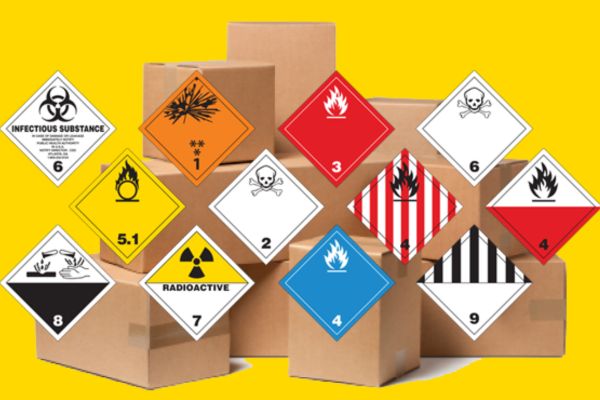What are the regulations on packages and containers of dangerous goods for transport by road motor vehicles in Vietnam?
What are the regulations on packages and containers of dangerous goods for transport by road motor vehicles in Vietnam?
Pursuant to Article 6 Decree 34/2024/ND-CP, the regulations on packages and containers of dangerous goods for transport by road motor vehicles in Vietnam are as follows:
(1) Packages and containers of dangerous goods within the territory of Vietnam must comply with the national technical regulations or national standards or specific legal regulations corresponding to the Class of goods. Packaging and containers for imported goods shall follow the recommendations and requirements of the manufacturer.
(2) In cases where national standards, national technical regulations, or specific legal regulations or international standards, technical regulations published by the Ministry managing the list of hazardous goods are not available, the following minimum requirements must be met:
- The quality of packaging and containers must withstand collisions and shocks during transport, transfers between vehicles, and loading and unloading into warehouses;
- Packaging and containers must ensure no leakage of hazardous substances during transport or under impacts such as shaking, temperature changes, humidity, and pressure;
- The outer surface of packaging and containers must be clean and free from any hazardous chemicals;
- Parts of packaging and containers in contact with hazardous substances must not be affected or have their quality degraded by the hazardous substances inside; should not affect the composition, properties, and functions of the hazardous goods;
- Packaging and containers for liquid hazardous goods must ensure no leakage or deformation due to volume expansion of liquids with temperature change; have appropriate resistance to internal pressure generated during transport; must be tested for leakage before dispatch;
- Inner packaging and containers made of fragile or puncture-prone materials like glass, ceramic, or some plastics must be stabilized with cushioning materials within outer packaging and containers;
- Packaging and containers for volatile substances must ensure containment to prevent evaporation during transport as per the manufacturer's requirements;
- Packaging and containers for hazardous goods in granular or powder form must prevent spillage during loading, unloading, and transport.
Packages and containers of dangerous goods for road transport within the territory of Vietnam must comply with national technical regulations or national standards or specific legal regulations corresponding to the Class of goods. Packaging and containers for imported goods shall follow the recommendations and requirements of the manufacturer.
In cases where national standards, national technical regulations, or specific legal regulations or international standards, technical regulations published by the Ministry managing the list of hazardous goods are not available, the above minimum requirements must be met.

What are the regulations on packages and containers of dangerous goods for transport by road motor vehicles in Vietnam? (Internet image)
Which authority has the power to grant the dangerous goods transport licence in Vietnam?
Pursuant to Article 17 Decree 34/2024/ND-CP, the authorities for granting licences in Vietnam are stipulated as follows:
Authority to grant licences and cases of exemption from grant thereof
1. The Ministry of Public Security organizes the issuance of licences for transporting hazardous goods of Classs 1, 2, 3, 4, and 9 according to Clause 1, Article 4 of this Decree (excluding plant protection chemicals and as stipulated in Clause 2 of this Article).
2. The Ministry of Defense organizes the issuance of licences for transporting hazardous goods for organizations and enterprises under the management of the Ministry of Defense.
3. The Ministry of Science and Technology organizes the issuance of licences for transporting hazardous goods of Classs 5 and 8 according to Clause 1, Article 4 of this Decree.
4. The People's Committees of provinces and centrally-affiliated cities organize the issuance of licences for transporting hazardous goods being plant protection chemicals.
5. The licence-granting authority shall decide the transport route and time based on the Class and Division of hazardous goods as stipulated in Clause 1, Article 4 of this Decree.
6. The issuance of licences for transporting hazardous goods of Class 7 shall comply with regulations concerning radiation activities and services supporting the application of nuclear energy.
7. licence-granting authorities shall refuse to issue licences for transporting hazardous goods being flammable and explosive substances if the transport route involves tunnels or ferries as regulated in Article 12 of this Decree.
Licences for transporting hazardous goods are granted by the competent Ministries. Additionally, the People's Committees of provinces and centrally-affiliated cities organize the issuance of licences for transporting hazardous goods being plant protection chemicals.
How are hazardous goods classified into classes and divisions under the law in Vietnam?
Pursuant to Clause 4 Decree 34/2024/ND-CP, hazardous goods are classified as follows:
Depending on the chemical and physical properties, hazardous goods are classified into 9 classes and divisions as follows:
- Class 1: Explosives and explosive items;
+ Division 1.1: Substances and items posing a mass explosion hazard.
+ Division 1.2: Substances and items posing a projectile hazard but not a mass explosion hazard.
+ Division 1.3: Substances and items posing a fire hazard and either a minor blast, or minor projectile hazard, or both, but not a mass explosion hazard.
+ Division 1.4: Substances and items posing a negligible explosion hazard.
+ Division 1.5: Very insensitive substances that pose a mass explosion hazard.
+ Division 1.6: Extremely insensitive items that do not pose a mass explosion hazard.
- Class 2: Gases;
+ Division 2.1: Flammable gases.
+ Division 2.2: Non-flammable, non-toxic gases.
+ Division 2.3: Toxic gases.
- Class 3: Flammable liquids and desensitized liquid explosives;
- Class 4:
+ Division 4.1: Flammable solids, self-reactive substances, and desensitized solid explosives.
+ Division 4.2: Substances liable to spontaneous combustion.
+ Division 4.3: Substances that, in contact with water, emit flammable gases.
- Class 5:
+ Division 5.1: Oxidizing substances.
+ Division 5.2: Organic peroxides.
- Class 6:
+ Division 6.1: Toxic substances.
+ Division 6.2: Infectious substances.
- Class 7: Radioactive materials;
- Class 8: Corrosive substances;
- Class 9: Miscellaneous dangerous substances and articles.
Thus, hazardous goods are classified into 9 Classes, in which Class 1 has 6 Divisions, Class 2 has 3 Divisions, Class 4 has 3 Divisions, Class 5 has 2 Divisions, and Class 6 has 2 Divisions.
LawNet
